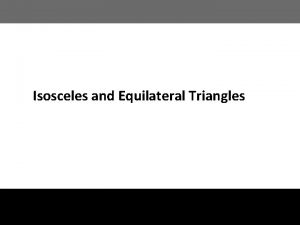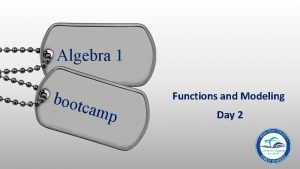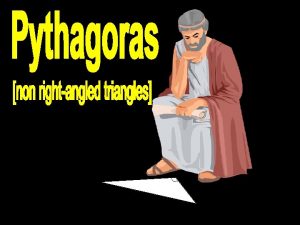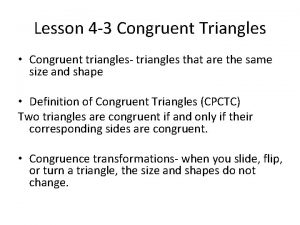7 6 NONRIGHT TRIANGLES Functions Modeling Change A








- Slides: 8

7. 6 NON-RIGHT TRIANGLES Functions Modeling Change: A Preparation for Calculus, 4 th Edition, 2011, Connally

The Law of Cosines: For a triangle with sides a, b, c, and angle C opposite side c, we have c 2 = a 2 + b 2 − 2 ab cos C A c b C B a Functions Modeling Change: A Preparation for Calculus, 4 th Edition, 2011, Connally

Proof of the Law of Cosines Applying the Pythagorean theorem to the right-hand right triangle: (a − x)2 + h 2 = c 2 or a 2 − 2 ax + x 2 + h 2 = c 2. Applying the Pythagorean theorem to the left-hand triangle, we get x 2 + h 2 = b 2. Substituting this result into the previous equation gives a 2 − 2 ax + (x 2 + h 2) = a 2 − 2 ax + b 2 = c 2. But cos C = x/b, so x = b cos C. This gives the Law of Cosines: a 2 + b 2 − 2 ab cos C = c 2. A ● h b C● x c a− x a ● B Triangle used to derive the Law of Cosines Functions Modeling Change: A Preparation for Calculus, 4 th Edition, 2011, Connally

Application of the Law of Cosines Example 1 A person leaves her home and walks 5 miles due east and then 3 miles northeast. How far has she walked? How far away from home is she? Solution Destination She has walked 5 + 3 = 8 miles in total. One side of the triangle is 5 miles long, x while the second side is 3 miles long 3 ◦ and forms an angle of 135 5 135° 45° Home with the first. This is because when the person turns northeast, she turns through an angle of 45◦. Thus, we know two sides of this triangle, 5 and 3, and the angle between them, which is 135◦. To find her distance from home, we find the third side x, using the Law of Cosines: , Notice that this is less than 8 miles, the total distance she walked. Functions Modeling Change: A Preparation for Calculus, 4 th Edition, 2011, Connally

The Law of Sines: For a triangle with sides a, b, c opposite angles A, B, C respectively: A c b C B a Functions Modeling Change: A Preparation for Calculus, 4 th Edition, 2011, Connally

Proof of the Law of Sines We derive the Law of Sines using the same triangle as in the proof of the Law of Cosines. Since sin C = h/b and sin B = h/c, we have h = b sin C and h = c sin B. This means that b sin C = c sin B and A similar type of argument (Problem 42) shows that . A b h c C B a Triangle used to derive the Law of Sines Functions Modeling Change: A Preparation for Calculus, 4 th Edition, 2011, Connally

Application of the Law of Sines Example 3 An aerial tram starts at a point one half mile from the base of a mountain whose face has a 60◦ angle of elevation. (See figure. ) The tram ascends at an angle of 20◦. What is the length of the cable from T to A? A c Solution T 20◦ a = 0. 5 mile 40◦ 120◦ 60◦ C The Law of Cosines does not help us here because we only know the length of one side of the triangle. We do however know two angles in this diagram and can determine third. Thus, we can use the Law of Sines: sin. A/a = sin. C/c or sin 40◦/0. 5 = sin 120◦/c So c = 0. 5 (sin 120◦/sin 40◦) = 0. 674. Functions Modeling Change: Therefore, the cable from T to A is 0. 674 miles. A Preparation for Calculus, 4 th Edition, 2011, Connally

When to Use the Laws of Cosines and Sines • When two sides of a triangle and the angle between them are known the Law of Cosines is useful. It is also useful if all three sides of a triangle are known. • The Law of Sines is useful when we know a side and the angle opposite it and one other angle or one other side. • The Ambiguous Case: There is a drawback to using the Law of Sines for finding angles. The problem is that the Law of Sines does not tell us the angle, but only its sine, and there are two angles between 0◦ and 180◦ with a given sine. For example, if the sine of an angle is 1/2, the angle may be either 30◦ or 150◦. Functions Modeling Change: A Preparation for Calculus, 4 th Edition, 2011, Connally
 Helen erickson biography
Helen erickson biography Dimensional modeling vs relational modeling
Dimensional modeling vs relational modeling 4-2 isosceles and equilateral triangles
4-2 isosceles and equilateral triangles Algebra 1 bootcamp functions and modeling answer key
Algebra 1 bootcamp functions and modeling answer key 2019 algebra 1 bootcamp answers
2019 algebra 1 bootcamp answers Algebra 1 bootcamp
Algebra 1 bootcamp Transforming quadratic functions
Transforming quadratic functions Algebra 1 bootcamp functions and modeling answer key
Algebra 1 bootcamp functions and modeling answer key Linear and quadratic functions and modeling
Linear and quadratic functions and modeling















